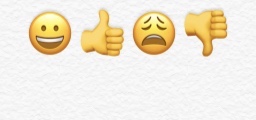 A person with whom I text regularly does not ever use emojis in her texts. I didn’t notice this at first, but as time passed, and more and more subjects were covered, it became clear that this was not a fluke, but a conscious choice. When I asked her about this, she seemed to have not noticed it herself, “No, I’ve never seen the need.”
A person with whom I text regularly does not ever use emojis in her texts. I didn’t notice this at first, but as time passed, and more and more subjects were covered, it became clear that this was not a fluke, but a conscious choice. When I asked her about this, she seemed to have not noticed it herself, “No, I’ve never seen the need.”
Figuring I would match in my responses, I decided to eliminate my own use of emojis for our conversations. And do you know what I found? It was darn hard! I’ve come to rely on emojis to add color, and nuance and commentary to my statements, and simply using language, the thing we have been using for centuries, suddenly seemed insufficient. I worried over statements and how they would be perceived, challenged to find the words to do what the shorthand of emojis have been doing for me.
The funny thing is how quickly this symbolic language has moved into our lives. Though the first emojis were developed in the late 1990s, their integration into smart phones didn’t happen until well after 2010 well behind the advent of texting. I remember seeing young people doing this and thought it was the most ridiculous thing. Soon afterward I began to see it in the texts of contemporaries, and even coworkers. I don’t remember the first time I added and emoji to a text. I’m sure I felt silly, but it wasn’t long before I regularly integrated them into the majority of my texts. So in less than 10 years we have moved from a text based language to a text and image based language with its own codes and syntax.
Though there are always jokes about communicating only with emojis, generally emojis are modifiers for language. I heard a podcast once that made a connection between current emojis and pictures in illuminated Medieval manuscripts, not the primary text, but indicating things about that text. Most of us use the thumbs-up emoji as a substitute for yes and thumbs-down for no, so some emojis have discrete meaning. But what does the heart emoji mean? Or the kissing emoji? Or the kissing emoji without a heart? Only the surrounding text can suggest meaning, just as simultaneously the emoji colors the meaning of the text. If I were to say, “I love you” with a heart, it’s pretty clear what that heart means. But if I were to say, “You are the greatest friend” with the same heart, the heart means something different.
Emojis have (luckily) remained primarily in the genre of text messaging. The inability for multiple platforms to read and reproduce them has kept them out of email (though as people rely more on others reading emails on a phone, I have seen these drifting in) and word processed documents whether on the screen or printed. This means that we are essentially speaking a different language when we text from other writing. I have felt this when I have thought to myself, “If only I could put a laughing face here, this paragraph would be so much clearer!”
Human evolution takes many paths, and sometimes there is a fundamental shift that we don’t recognize until we try to step it back. I’m not saying that developing image language is as important as walking upright, but I challenge regular texters to go without it for one week and feel how often the tug is there. That is Mother Nature saying that you have changed and you didn’t know it.
Be safe, be strong.
Today’s playlist: https://open.spotify.com/playlist/2Hg9uLe4rwE59uqgMBUsla?si=QmmCJtY3R9eS6KjWZe5KwA
😁❤️😉